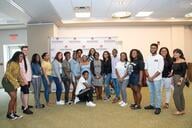You have /5 articles left.
Sign up for a free account or log in.
My children and parents were in bed before 10 p.m. one night over the holidays. I sat at the dinner table with my brothers and our spouses. Quick glances around revealed that we all, miraculously, had enough energy for a game of cards. I knew a game that was the perfect balance of fun and simple. In the time it took me to push back my chair and stand up I’d fully morphed into professor mode. I launched into a mini-lecture to teach them how to play.
As an assistant professor in the physics department at Yale University, I am in my groove when I’m giving a lecture. Physics is a gorgeous subject, and shockingly counterintuitive even at the introductory level. You start students with the big picture. Armed with mathematics, you land on specific examples that shatter the framework they, maybe unwittingly, had developed for the natural world in their 18-plus years of walking around and paying attention.
What do you mean an object in motion stays in motion without an external force? How can it be that a ball you drop and a ball you throw horizontally will reach the ground in the same time? Doesn’t that thrown object have additional oomph that translates into more time aloft?
And this is well before we get into 20th-century physics. You can’t outpace the constant speed of light even if you let that flashlight beam loose from the front of a charging train. And the realm of the microscopic, with destiny governed by probability in the calculations of quantum mechanics, calmly tosses determinism out the window.
When your excitement for something you love is contagious, heads nod and questions fly. And the fact that the lesson can so easily turn catastrophic, with an extra minus sign or a botched explanation, kicks up the stakes. The students who sleep or text provide immediate feedback that you have failed to engage everyone. The even balance between the times I leave class victorious and the times I’m ready to crawl under a table reminds me that teaching is one of those activities that will forever label me, “needs to improve.” That’s fine. I like to improve.
But this mini-lecture over the holidays wasn't one of those obvious catastrophes. I’d started with the foundation, telling them the big-picture goals of the game. Only when heads were nodding did I move to details, being sure to come back around to specific examples and the “here’s how you win” take-home. It was so smooth and we were so together in it that I mentally noted, “this is what it feels like to give a good physics lecture.”
That perceived connection makes what follows particularly humiliating.
I’d barely hit my seat when my older brother piped up with, “I have no idea how to play the game.”
I was shocked. I immediately turned to my husband. He knew the game well and isn't afraid to give me honest feedback, but he justified my confusion by stating, “That was a beautiful explanation!” Someone who knows the material is best placed to recognize a well-crafted presentation, but not necessarily an effective one.
I turned back to my brother and asked, “Why were you nodding your head if I wasn’t making sense?”
He replied, “You were making sense. Everything you said made sense as you said it. But now that you’re finished, I don’t know how to play the game.”
By now my brothers were between giggling and guffawing at my consternation. My younger brother gently suggested, “Maybe if we just start playing the game we can learn as we go?” And it dawned on me that this had been quite close to a typical physics lecture indeed.
We all know that we can learn by doing. Many of us realize that we learn best by teaching. The act of gathering together the loose ends and tying them up into our own explanation, what I’ve learned to call “constructing my own knowledge” thanks to education research, is the surest way to adjust our existing framework. Constructing our own knowledge isn’t about getting us through the next test, but is about fundamentally adjusting how we view the world.
A set of well-tested interventions that can improve learning in traditional lecture courses are collectively known as “active learning.” These activities seem most effective when carried out in small groups. To make the group work less awkward, instead of sitting in rows in a lecture hall and staring at me, my students in introductory physics sit around tables and stare at each other. It can still be awkward. Reminders that this is not just about having fun or being educationally trendy, but is instead about using our time effectively, are a necessary part of my routine.
When I handed out sheets of aluminum foil a few weeks ago in the middle of class I felt as if I were balancing on a high wire. Any hint that I am wasting their time sends students reaching for laptops to check email. The slightest sense that I am treating them more like my six-year-old than as budding scholars sends them to Facebook or to an assignment for another course.
I gave instructions for the students to wrap one of their phones in aluminum foil and to call it. The wrapped phones didn’t ring. Their mission was to come up with an explanation.
I had told them weeks before that there are no electric fields inside conductors and tried to motivate why. I’d also derived the behavior of electromagnetic radiation from fundamental equations, revealing it to be electric and magnetic fields traveling at the speed of light. The signal to their phones (electromagnetic radiation) did not pass into the enclosure of aluminum foil (a conductor.) Their mini-experiments, surprise, five minutes of discussion, and a two-minute classroom-wide conversation resulted in learning that the theory alone didn’t deliver.
There is a place for lectures in education. They can introduce, motivate and contextualize material.
However, we often want classroom time to go beyond equipping students to learn and into actual learning. My failed attempt to teach the card game is serving as a parable.
It warns me away from the false security of a lecture that feels good and might be admired by my colleagues but accomplishes little with the students.
If we want them to learn we need to cede time to them to struggle with loose ends. We need to let them play the game.




